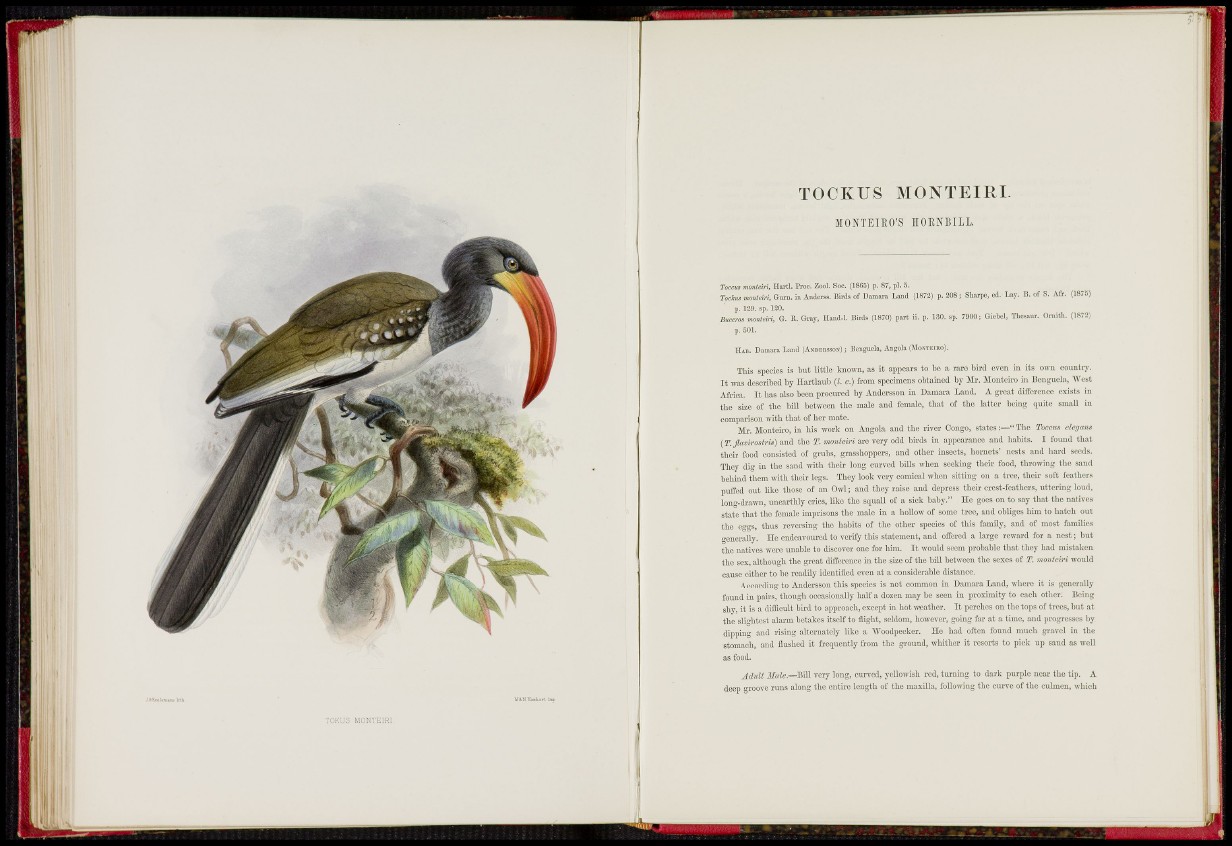
TOCKUS MONTEIRL
MONTEIEO'S HOENBILL
Toccus monteiri, Hartl. Proc. Zool. Soc. (1865) p. 87, pi. 5.
Tochig monteiri, Gurn. in Anderss. Birds of Damara Laiid (1872) p. 208; Sliarpc, ed. Lay. 15. of S. Afr, (1875)
p. 129. sp. 120.
Buceros monteiri, G. R. Gray. Iland-I. Birds (1870) part ii. p. 130. sp. 7900; Giebcl, TKesaur. Omith, (1872)
p. 501.
HAD. Damara Lruid (ANDERSSON) ; Bcngucla, Angola (MONTEIRO).
This species is but little known, as it appears to be a rare bird even in its own country.
I t was described by nartlaub (I. c.) from specimens obtained by Mr. Jlontciro in Benguela, "West
Africa. It has also been procured by Andcrsson m Damara Land. A great difference exists in
the size of the bill between the male and female, that of the latter being quite small in
comparison with that of her mate.
Mr. Monteiro, in his work on Angola and the river Congo, states:—"The Toccus elegans
(T.Jlavirostris) and the T. montewi are very odd birds in appearance and habits. I found that
their food consisted of grubs, gi-asshoppers, and other insects, hornets' nests and hard seeds.
Tliey dig in the sand with their long cm-ved bills when seeking their food, throwing the sand
behind them with their legs. They look very comical when sitting on a tree, their soft feathers
puifed out like those of an Owl; and they raise and depress their crest-feathers, uttering loud,
long-drawn, unearthly cries, like the squall of a sick baby." lie goes on to say that the natives
state that the female imprisons the male in a hollow of some tree, and obliges him to hatch out
the eggs, thus reversing the habits of the other species of this family, and of most families
generally. He endeavoured to verify this statement, and oiTered a large reward for a nest; but
the natives were unable to discover one for him. It would seem probable that they had mistaken
the sex, although the great difference in the size of the bill between the sexes of T. monieiri would
cause either to be readily identified even at a considerable distance.
According to Andersson this species is not common in Damara Land, where it is generally
found in pairs, though occasionally half a dozen may be seen in proximity to each other. Being
sby, it is a difficult bird to approach, except in hot wather. It perches on the tops of trees, but at
the slightest alarm betakes itself to flight, seldom, however, going far at a time, and progresses by
dipping and rising alternately like a Woodpecker. He bad often found much gravel in the
stomach, and flushed it frequently from the ground, whither it resorts to pick up sand as well
as food.
Adult ilfaZe.—Bill very long, curved, yellowish red, turning to dark purple near the tip. A
deep groove runs along the entire length of the maxilla, following the curve of the culmen, wliich
T O K U S MONTEIRI